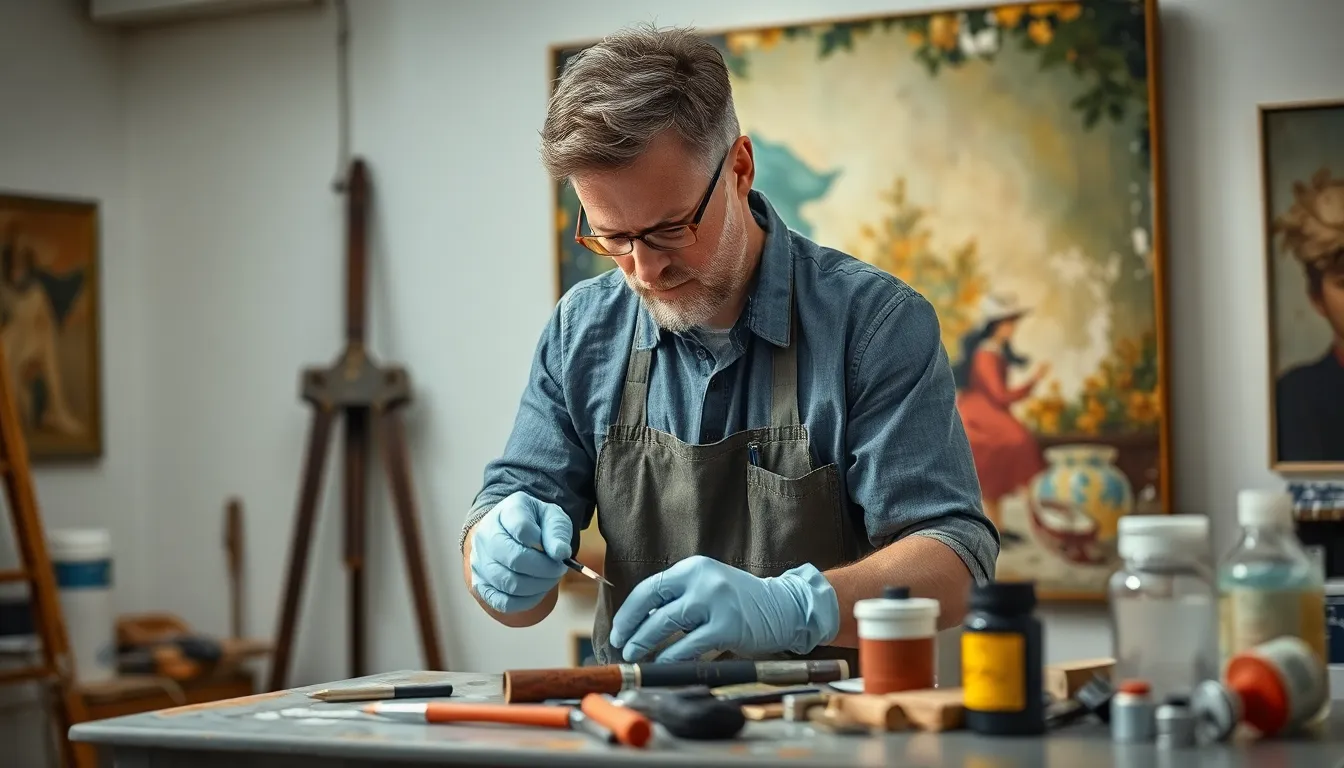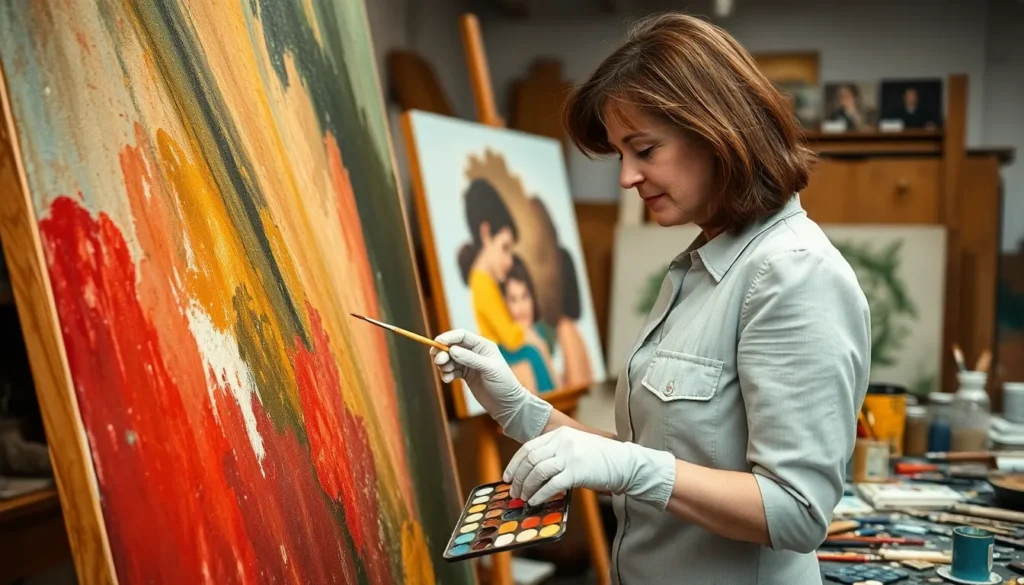Table of Contents
ToggleArt is like that friend who shows up to the party looking a bit worse for wear but still manages to steal the spotlight. Over time, masterpieces can lose their charm due to wear and tear, environmental factors, or even the occasional clumsy moment. That’s where the art restoration process steps in, ready to work its magic and breathe new life into those beloved pieces.
Imagine a team of skilled professionals armed with brushes, solvents, and a dash of creativity, all dedicated to preserving the beauty of art for future generations. They don’t just fix things; they embark on a thrilling adventure, uncovering hidden details and restoring the original glory of each work. Join us as we dive into the fascinating world of art restoration and discover how these unsung heroes keep the art scene vibrant and intact.
Overview of Art Restoration Process
Art restoration encompasses a series of meticulous steps aimed at reviving and preserving artwork. Initial assessment is critical, as restoration experts evaluate the condition of the piece. This evaluation addresses damage types, such as fading, cracking, or loss of paint.
Following assessment, cleaning surfaces becomes necessary. Specialists use soft brushes and chemical solutions to remove dirt and grime without harming the original material. Techniques vary depending on the artwork’s medium, whether canvas, sculpture, or fresco.
In cases where paint has deteriorated, retouching plays a significant role. Artists carefully match colors and apply them in a way that blends seamlessly with the original work. This process restores not only the piece’s appearance but also its integrity.
Sealing the work often comes next. Conservation-grade varnishes protect artwork from future damage, such as UV rays and humidity. These protective layers ensure longevity while allowing the underlying art to breathe.
Collaboration occurs throughout the art restoration process. Restorers may work alongside historians and chemists to choose appropriate materials and methods. This teamwork enhances transparency and maintains the work’s historical context.
Documentation serves as an important aspect as well. Each procedure, material, and condition is recorded for future reference. This information provides transparency and helps assess the work’s status over time.
Art restoration exemplifies a balance between artistry and science. Trained professionals engage in this intricate process to maintain and celebrate our cultural heritage. As artworks endure, skilled restoration allows them to continue captivating audiences for generations.
Importance of Art Restoration

Art restoration plays a crucial role in maintaining and celebrating artistic heritage. It serves to ensure that significant pieces remain accessible for future audiences.
Preserving Cultural Heritage
Artworks often reflect the unique history and creativity of cultures. Through restoration, experts safeguard these narratives, allowing them to span generations. Restoration practices uphold originality while addressing deterioration, ensuring the piece retains its authenticity. Communities benefit from restored artworks, as they foster a sense of identity and pride. Historical context becomes clearer as restorers reveal hidden details, improving understanding of cultural significance. The restoration process contributes to the collective memory, making it vital for educational purposes. Thus, without restoration, essential aspects of a culture risk fading away.
Enhancing Aesthetic Value
Restoration improves the visual appeal of an artwork. By meticulously repairing damage, art restorers bring back the vibrancy and charm that may have diminished over time. Color matching techniques assist in recreating lost areas, ensuring a cohesive appearance. Viewers experience the artwork as intended by the original artist, eliciting admiration and emotional responses. Skills honed through years of practice allow restorers to make informed decisions about which materials to use. A restored piece can captivate again, drawing audiences closer and inspiring deeper appreciation. Enhancements in aesthetic value elevate not just individual pieces, but also the overall cultural landscape.
Steps in the Art Restoration Process
Art restoration involves a series of precise steps to ensure optimal preservation and aesthetic integrity. Each stage plays a vital role in reinvigorating masterpieces for current and future audiences.
Assessment and Documentation
Restorers conduct a thorough assessment of the artwork’s condition. Experts identify damage types, such as fading, cracking, or loss of paint. They document findings meticulously, noting materials, techniques, and previous restorations. This documentation establishes a baseline for future reference and enhances the transparency of the restoration process. Comprehensive assessments also guide decisions on appropriate cleaning methods and materials, ensuring that actions taken align with the artwork’s needs.
Cleaning and Stabilization
Cleaning comes next, as experts prioritize the removal of dirt, grime, and surface contaminants. They use soft brushes and specific chemical solutions customized for each medium, ensuring no further damage occurs. Stabilization involves addressing any loose components or structural weaknesses, using archival materials to reinforce integrity. This step is crucial for maintaining the artwork’s original look while preparing it for subsequent repairs. Techniques focus on preserving the artwork’s unique features without altering its essence.
Repair and Reconstruction
Repair involves meticulous work to restore the artwork’s visual coherence. Skilled restorers carefully match colors using modern pigments that closely resemble the original. They apply these colors to areas where paint has been lost, ensuring alignment with overall patterns and textures. Reconstruction may involve filling in missing sections or reinforcing fragile areas to prevent future deterioration. This balancing act maintains the work’s authenticity while revitalizing its aesthetic appeal. Fine attention to detail defines this stage, allowing the artwork to shine as initially intended.
Final Conservation
Final conservation entails applying a protective layer, such as conservation-grade varnishes. These coatings safeguard the artwork from environmental factors like moisture and light exposure, which can lead to decay. Additionally, varnishes ensure the art remains stable and visually vibrant over time. Restorers also verify the work’s condition after the conservation process, ensuring that all objectives have been met. Through this meticulous approach, the artwork stands ready to engage audiences while preserving its historical significance.
Challenges in Art Restoration
Art restoration presents several challenges, requiring careful navigation of complex issues.
Ethical Considerations
Ethical considerations rank among the most significant challenges. Restorers often face dilemmas about the extent of intervention. Maintaining originality is crucial while addressing damage and wear. Different perspectives exist regarding how much restoration maintains the artist’s intent without compromising authenticity. Experts frequently debate whether retouching or reconstruction alters the historic narrative of the piece. Consent from collectors or institutions also factors into decisions made during the restoration process. Preserving the authentic story behind cultural artifacts enriches their value and educational purpose.
Material Limitations
Material limitations pose another substantial challenge. Various artworks utilize different materials, each with specific properties. For instance, oil paints, acrylics, and watercolor react differently to cleaning agents and restoration techniques. Resins and adhesives used must be compatible with the original materials, avoiding potential damage. Limited availability of authentic materials may hinder restoration efforts. Additionally, aging and environmental exposure can alter the chemical properties of these substances. Experts strive to source suitable alternatives that maintain integrity while tackling deterioration. Balancing the use of modern materials and techniques with traditional methods proves essential in achieving a successful outcome.
Art restoration is more than just a technical process; it’s a commitment to preserving cultural heritage and artistic expression. Through careful assessment and skilled intervention, experts breathe new life into masterpieces, ensuring they remain vibrant and accessible. The collaboration among various professionals enriches the process, allowing for a deeper understanding of each artwork’s historical context.
By navigating the challenges of material limitations and ethical considerations, restorers uphold the integrity of the original piece while revitalizing its aesthetic appeal. This delicate balance not only safeguards the narratives embedded in art but also fosters a sense of pride within communities. Ultimately, the art restoration process plays a vital role in keeping our shared history alive, allowing future generations to appreciate and connect with the creativity of the past.



